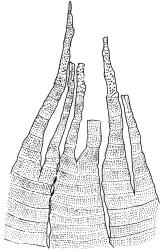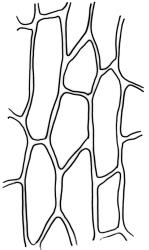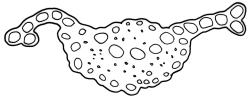- ≡ Dicranodontium lineare Mitt. in Hooker, Handb. New Zealand Fl. 413 (1867)
Plants yellow-green when fresh, becoming brown when dry and old. Stems c. 2–5 mm. Leaves neither sheathing nor strongly shouldered. Lower leaves mostly 1.5–3 mm, narrowly ovate-lanceolate, acuminate, serrulate above, entire or crenulate below, keeled, mostly unistratose but bistratose at margins. Upper leaves (including perichaetial) c. 4–7.5 mm, lanceolate-subulate, gradually tapered from a narrowly ovate base c. ⅕–¼ the total leaf length, with a slender and keeled subula that is nearly filled by the costa. Upper laminal cells (in leaves from below perichaetium), short-rectangular, rounded at corners, mostly 12–15(–21) × c. 6 µm and (1–)2–3:1, those at margin bistratose and projecting at upper ends. Costa (in leaves from below perichaetium) occupying c. ¼ the width of the leaf base and well defined, not filling the upper subula, spinose abaxially near apex by projecting cell ends.
Paroicous. Perichaetia often >1 per stem. Perigonia on short stalks immediately below the perichaetia, the outer bracts acute and often with 1–2 inner bracts much reduced and obtuse. Setae 2.5–5 mm, cygneous when moist; capsules emergent (not or scarcely exceeding perichaetial leaves), broadly ovoid, 0.8–1.2 mm, slightly asymmetric at base, with a small and weakly strumose sterile neck; exothecial cells and annulus as per genus; stomata superficial; operculum c. 0.6 mm. Peristome as per genus. Spores 21–24 µm.
Giese & Frahm 1986, figs. 23–36, 42.
Confusion with several species occurs; that with C. capillaceum (=C. medium) being the most frequent. The leaves in the present species have an ovate base gradually contracted to the narrow subula, while those of C. capillaceum have an oblong and shouldered base abruptly tapered to the subula. The nature of the leaf margin and sexuality also differ.
Campylopodium lineare is sometimes confused with Orthodontium lineare but can be readily distinguished by the nature of its single dicranaceous peristome, its shorter (2.5–5 mm) and cygneous setae, and its short capsules. By contrast O. lineare has a double peristome in which the pale endostome segments are longer than the teeth and conspicuous when dry, much longer and flexuose setae, and longer (mostly 2.0–2.5 mm) capsules, as well as many other features. Confusion also sometimes occurs between C. lineare and both Amphidium cyathicarpum (q.v.) and Campylopus pyriformis.
NI: Taranaki (Mt Egmont), Wellington (Mt Ruapehu, Akatarawa Range, Mt Bruce); SI: Nelson (Little Wanganui River, s. loc.), Canterbury (Avalanche Peak, Bealey Glacier Track), Westland (Ōtira Gorge, Waiuta, Clarke River), Southland (Stuart Range).
Probably Australasian. Reported from Tasmania by Giese & Frahm (1986), and accepted from that island by Dalton et al. (1991). According to Lyn Cave (pers. comm., 12 Oct. 2017) there are several Tasmanian collections in HO.
On mineral earth, occasionally on accumulated soil over wood; usually in southern beech forest. From near sea level (Little Wanganui River) to c. 1200 m (Mt Ruapehu).
Campylopodium lineare remains a poorly documented species with collections known from only two North I. L.D. and from scattered South I. localities near to or west of the Main Divide.
The protologue cites an H.H. Travers collection from an unlocalised Canterbury locality, but no such collection can be located in N.Z. herbaria. An unlocalised Travers collection from Nelson is present in CHR (543121!), and this specimen may be a portion of the type. Giese & Frahm’s (1986, p. 131) citation of a Hutton & Kirk collection as the type is incorrect.
Type material of Cynodontium tasmanicum Broth. & Rodway, which was placed in synonymy with the present species by Giese & Frahm (1986), has not been available for study. Some Tasmanian material named as Cynodontium tasmanicum in AK is referable to C. medium.
Sainsbury suggested (1955, p. 100) that C. lineare could be accommodated in the predominantly north-temperate genus Cynodontium Schimp., and its similarity to that genus is emphasised by bistratose leaf margins and paroicous sexuality. However, C. lineare would be anomalous in Cynodontium by its smooth laminal cells (Ireland 1994) and by its geographic distribution; it is retained here in Campylopodium.















